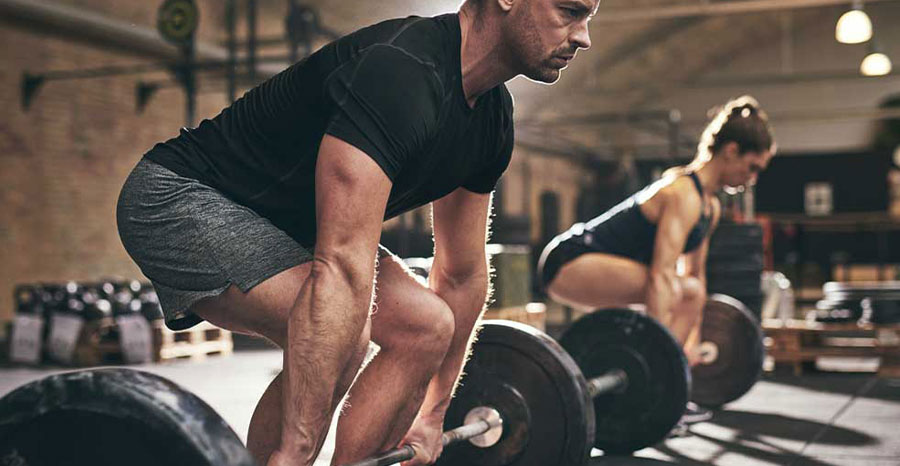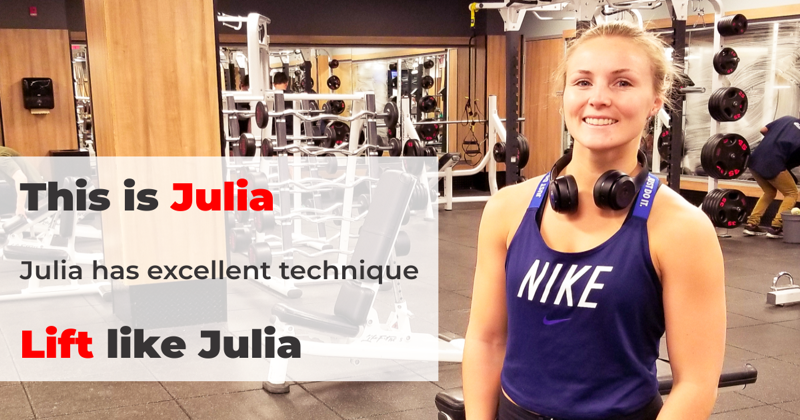
How to Lift Safely: Protecting Your Upper Body
In part 2 of 2 of this series, Julia once again demonstrates proper lifting technique. Proper technique will prevent lifting injuries and optimize your results. Click here for Part 1: Protecting Your Back.

The Top 6 Upper Body Lifts and How To Do Them Right!
Barbell Curls & Dumbbell Curls
While repetitive strain injuries to the biceps and connective tissues at the elbow can result from doing curls, either from weights that are too heavy or from excessively high reps. the injury that occurs most commonly from doing curls incorrectly are pulls and tears in the lower back.
As with all exercises notice how Julia keeps her lower back straight. There is absolutely no part of her curl that is coming from the back. Ballistic motions, or ‘throwing’ the weight by arching the back and thrusting the hips forward will almost certainly result in injury sooner or later. If you need to do these kinds of motions to move the weight, it’s too heavy. I promise you’ll get better results by lowering the weight and lifting with control.
Julia bends slightly at the hips and knees when she does upper body lifts. Simply due to the differences in weight and muscle distribution between the genders, many women find this posture to be more comfortable and to impart greater control over the lifting motion. Men often prefer to stand straight upright. Neither posture is right or wrong. It comes down to what works for you. If you are lifting by standing perfectly upright, though, be sure you are not placing excessive strain on your lower back. Especially avoid leaning back at any time during the lift.
As with the barbell lift, notice how the motion is entirely from the elbows. There should be little or no movement of any other part of the body, including the back, hips or shoulders. Some small movement at the shoulders may be unavoidable. Be sure to lower the weight fully and lift smoothly. Don’t ‘drop’ the weight from the raised position. This can easily lead to a muscle pull when ‘catching’ it at the bottom. Lower the weight as smoothly as you raised it.
Shoulder Press
While shoulder presses can be done with either dumbbells or a barbell, they are safest when done seated. This will all but ensure that you will avoid injury to your lower back. In some cases standing shoulder presses (also called military presses) may be required if you are seeking to improve core strength and stability and/or training for powerlifting. In these cases, be sure not to have an excessive inward arch to your lower back. Incorrect technique in a standing shoulder press will be evident from pressure on your lower back, and a sensation that you are lifting as much with your pecs as your shoulders. It is absolutely necessary to avoid this poor posture when doing a standing shoulder press as this can result in severe lower back injuries.
If doing seated dumbbell presses, and the dumbbells are too heavy to curl into the lifting position, place the dumbbells flat on your knees. By assisting the lift with your leg you’ll be able to impart enough extra force to raise the weight into position. Do one at a time and be sure not to twist your back when doing this.
Tricep Extensions
You know I’m gonna say it…see how Julia keeps her back and shoulders almost absolutely still. The entire motion is done from the elbows. Also note that she keeps her elbows at her sides throughout the motion. Don’t raise your elbows at the top of the lift. The resulting downward pull that starts at the shoulders can cause an injury to the triceps, rhomboids or trapezius.
As a safer alternative to tricep extensions, you can try head crushers. Get a bar and lie supine on a flat bench. Extend the weight straight above your head. Moving only from the elbows, lower the weight until it is just above your head. You can touch your hands to the bench but note that doing so will require some movement from the shoulders. Head crushers will greatly reduce the risk of a lower back injury over doing tricep extensions, but increase the risk of injury to the triceps and muscles of the upper back. If you elect to work your triceps with head crushers, as with all movements lift with control.
Bench Press
Us guys are the worst offenders for doing bench press wrong. In the pursuit of impressive pecs many men lift too heavy on the bench and use a number of ‘cheats’ to compensate. Don’t bounce the weight off your chest. In fact, you should stop the motion of the bar at least a couple of inches off your chest, unless your chest measurement is 50 inches or more. Lowering the weight all the way to your chest results in a hyper-extension of the shoulders. The injury that can result is one I have personal experience with. Years ago I tore my right shoulder at the medial end by lifting too heavy and dropping the weight all the way to my chest. It took six months to heal and another six to regain the lost strength in the affected muscles. That’s a full year of progress lost due to one injury!
Lift as Julia is and you’ll greatly reduce the risk of ever suffering a shoulder or pec tear. These tears can be especially serious, sometimes requiring surgery to repair and healing is always measured in months. To make matters worse, sometimes the muscle will never be as strong again.
Lat Pulldown
Here’s another one I see people doing wrong all the time at the gym. Never ‘row’ the weight. Your back should remain absolutely still. All motion is from the shoulders. The very slight arch of Julia’s back at the bottom of the motion is in fact her squeezing her upper back muscles. This is good technique. Any motion of the lower back is not only poor form that will rob you of development for your lats, but also puts you at extreme risk of a lower back injury. If you have to row the weight, it’s too heavy. Lower the weight and lift with control.
Getting Top Results
This post on how to lift safely is part of a series on getting the best possible results. If you want to build a strong body as quickly as possible we strongly suggest you also read these previous posts:
- How We Build Muscle: Physiology 101
- Fast Muscle Growth: Physiology 101
- The Top 6 Training Mistakes That Are Costing You Muscle
- Bodybuilding: What You Don’t Know About Protein Powders
Will Dove
Latest posts by Will Dove (see all)
- Body Weight Training 2.0: Calisthenics - 22 Apr
- All About Protein Powders - 9 Apr
- Top 5 Fitness Trends for 2019 That You Should Try - 30 Mar
